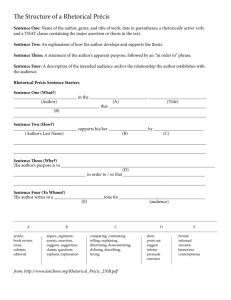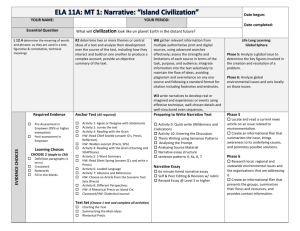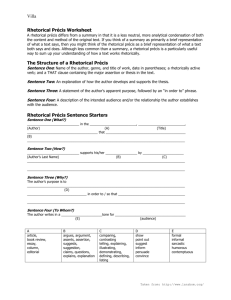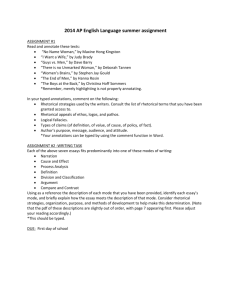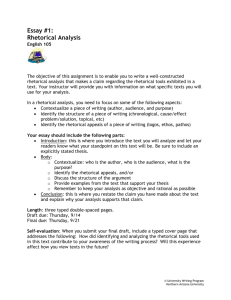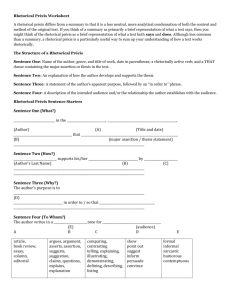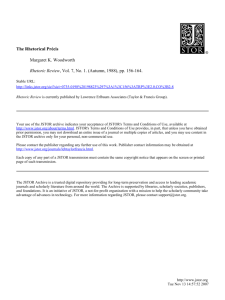Writing the Rhetorical Precis
advertisement
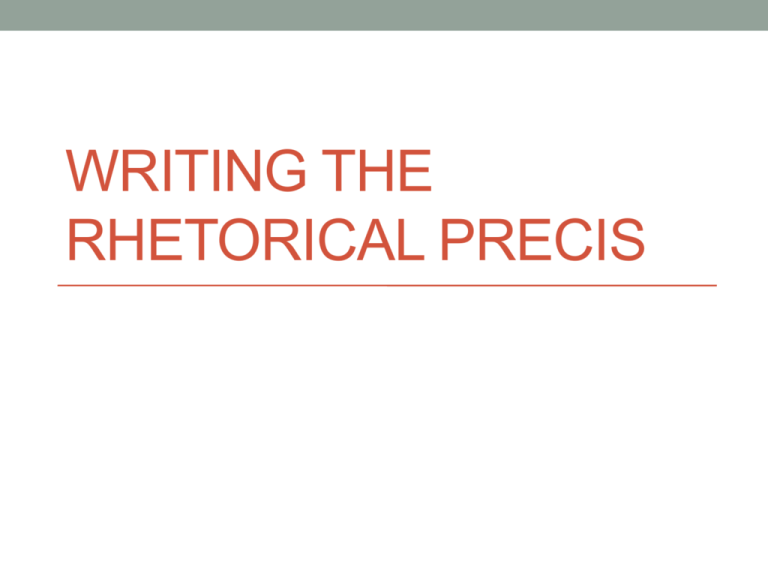
WRITING THE RHETORICAL PRECIS The Rhetorical Precis • The précis (pronounced pray-see) is a highly structured four sentence paragraph that records the essential aspects of a text or argument. Each of the four sentences requires specific information. A diagram of the rhetorical précis 1. What • Include author, genre, title and a rhetorically active verb • (argues, suggests) 2. How • Explain how the author develops his or her thesis 3. Why? 4. To Whom? • Describe in a sentence the author’s apparent purpose, including an “in order to” phrase. • …in order to show • …in order to point out • Describe the likely intended audience and/or the relationship the author establishes with his or her audience • Discuss tone 1. What A (genre) • (news/magazine/ journal) article book review, editorial, first-hand report, personal or biographical essay, biography, research report 2. How B (Rhetorical verb) 2. How C (by) • analyzes/analysis argues/argument, asserts/assertion, discusses/discussion, focuses on/focus explains/explanation • comparing / contrasting retelling, explaining, illustrating, defending, demonstrating, defining, describing, listing, arguing, showing, justifying, relating, reporting, noting, emphasizing, pointing out, highlighting the fact 3. Why D (in order to) • argue, call attention to, deny, show, point out, prove suggest, inform, persuade, disclose, report, Convince 4. To Whom? E (register/tone) • formal, impersonal casual, informal • humorous, emotional, friendly, reasoned, logical, exaggerated The Rhetorical Precis Format • Sentence 1 • In a single coherent sentence give the following: • Name of the author, title of the work, source and date (in parentheses); • A rhetorically accurate verb such as “asserts,” “argues,” “refutes,” “proves,” or “explains.” • A that clause containing the major claim (thesis statement) of the work. THE WHAT The Rhetorical Precis Format • Sentence 2 • In a single coherent sentence give an explanation of how the writer develops and supports the major claim (thesis statement). THE HOW The Rhetorical Precis Format • Sentence 3 • In a single coherent sentence give a statement of the author’s purpose, followed by an “in order to” phrase. THE WHY The Rhetorical Precis Format • Sentence 4 • In a single coherent sentence give a description of the intended audience and/or the relationship the author establishes with the audience. • TO OR FOR WHOM Student Sample Rhetorical Precis Sentence 1 bell hooks, in her essay, “Women Who Write Too Much,” from Remembered Rapture (1999), suggests that all dissident writers, particularly black female writers, face enormous time pressures, for if they are not prodigious, they are never noticed by mainstream publishers. Sentence 2 Student Sample Precis • She supports her position first by describing her early writing experiences that taught her “not to be afraid of the writing process”; second by explaining her motives for writing, including “political activism”; and lastly by affirming her argument, stressing that people must strategically schedule their writing and “make much of that time.” Student Sample Sentence 3 • Her two-pronged purpose is to respond to critics and to encourage minority writers to develop their own voice. Student Sample Sentence 4 • Although at times her writing seems almost didactic, hooks ultimately establishes a companionable relationship with her audience of both critics and women who seek to improve the effectiveness of their own writing. Sources: Center for Teaching and Learning. The Rhetorical Précis. University of Texas at Austin. Web. March 2012 Ellerhoff, Jean D. Writing the Rhetorical Précis. Central Academy. Web. March 2012


